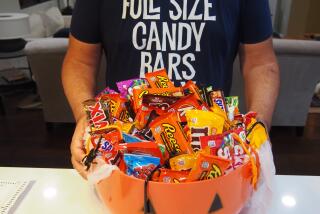Scare up a plan to deal with a Halloween horror
- Share via
Haunted by the fear of sugar highs at your house? Some experts share their favorite tricks on how to handle Halloween treats:
* “We used to tell our [own] kids, ‘This is your week for candy.’ Things we really liked, we ate, and we threw the rest out.
“If children eat too much candy, they’ll probably have an upset stomach. Then they may decide they don’t want that much candy all the time.
“Having fewer rules is a lot better. As children discover what they like, they will naturally gravitate to healthy food.
“It’s not good. It’s not bad. It’s just a piece of candy.”
-- Carol Koprowski, registered dietitian and professor at USC.
--
* “It’s good if parents go along on the trick-or-treating -- and walk. That way, you work off some of the extra energy. Schedule for the evening: Collect everything. Bring it home. Parents check to see that it’s all safe. Choose one or two pieces to eat. Decide what to do with the rest.
“The best thing for parents to do on Halloween is to teach children that candy is OK as an occasional food. Take a piece tonight. Put it away. Have it over time.
“If you believe your child responds to sugary food, plan how to handle that. Usually that means: one piece.
“My concern about Halloween -- it’s the beginning. The days are shorter. You may be a little less active. You start eating these foods, and then here comes Thanksgiving, then Christmas. You need to think about what you’re eating. Don’t get into a pattern of eating sweets and not stop until January.”
-- Jo Ann Hattner, registered dietitian and nutrition instructor at Stanford University School of Medicine.
--
* “I promote the use of alternative treats -- stickers, glow sticks, crayons, bubble-blowers. . . . One year I gave out orange pencils with pumpkins on them. Kids got so excited because it was different. Some friends of mine have games, like carnival games, so kids get treats as prizes. They have people lined up at their house.
“For families that just can’t get away from candy, don’t buy it till that afternoon. (It’s typical to buy it and eat it before Halloween even gets here.) Afterward, get rid of it right away.
“Your kids are going to get a lot of candy. Have them pick their favorite five and eat one a day for five days. The rest -- donate. Just get it out of sight. Hopefully the shelters or wherever you bring it will throw it away.
“Kids come up with the best solutions, and when they do, they have much more motivation to follow through.”
-- Dr. Thomas Robinson, professor of pediatrics at Stanford University School of Medicine and director of the Center for Healthy Weight at Lucile Packard Children’s Hospital.
--
* “Let your kids go trick-or-treating. You don’t want to deprive them. You can figure out ways of minimizing the damage for this rare occasion.
“Make sure they get a well-balanced meal before they go. When they come back with a bag of candy, let them choose a handful they want to keep for themselves.
“Give away the rest. It’s the parents’ choice what to do. You can even throw it away. It will do a lot less damage in the garbage than in kids’ bodies.
“Let kids enjoy some of the candy. It’s not boot camp. But set reasonable limits. That’s a key parenting practice.
“Give kids a small, healthy snack before they have a candy or two. . . . Then let them enjoy it guilt-free. If they’re going to eat it, they should get to enjoy it.
“When kids pick out their handful, the parents need to maintain control over it, so a kid has to ask for a piece. Then the parent should give it guilt-free, but be sure the child has a healthy snack first. That way parents can keep children from eating all six at a time, and keep them from getting sick.”
-- Dr. David Ludwig, professor of pediatrics at Harvard Medical School and director of the Optimal Weight for Life program at Children’s Hospital Boston.


